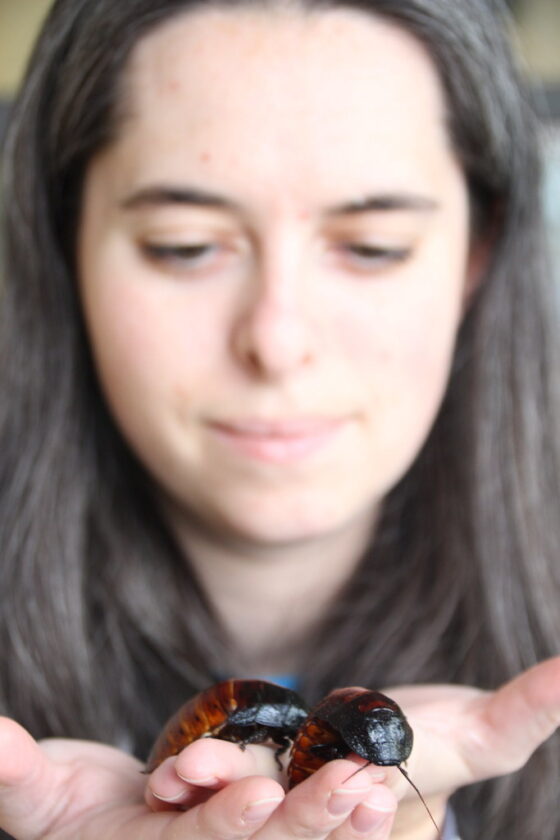Overcome your fear of risk with cockroach therapy

Submitted Photos Madagascar Hissing Cockroaches are fantastic educational animals, and help show that it is possible to overcome our fears. They are some of the biggest cockroaches on earth.
Audubon is home to a number of animal ambassadors. Most of these are well known to our visitors: birds of prey, snakes, turtles, fish, hellbenders, and an ancient one-eyed toad. These animals serve a valuable role at Audubon. They teach visitors about native species, various animal adaptations, and give visitors an up-close look at critters that can sometimes be hard to study in the wild. The staff takes pride in the animals and love seeing visitors interact with them.
There are also hidden animals that are not on display to the public. These critters are often misunderstood, and sometimes feared. The back corner of the education office is home to a small colony of cockroaches.
These aren’t your average, everyday cockroaches. These roaches are Madagascar Hissing Cockroaches, one of the largest cockroach species. They are quite bulky and can grow up to 2.5 inches long. They are flightless and relatively slow, often crawling at a leisurely pace.
While they are definitely not a native species, we have found these critters to be excellent educational tools. The large size makes it easy to see their body parts and adaptations. Their calm demeanor allows them to be easily handled, even by small children. They even have a few “party tricks” that can provide entertainment. As their name suggests, these insects make a hissing noise when disturbed, as they forcefully expel air from their abdomens. They are also able to flip themselves upright when placed on their backs. Both of these tricks are wildly popular with our young campers and students.
My favorite part of teaching with these insects isn’t actually the insects themselves, but the reactions of the people who meet them. Many people have very strong reactions when they first see the roaches. Usually, it’s a reaction of either fascination or disgust, but can be a hefty mix of the two.

When teaching with the roaches, we often offer to let people to touch them, or even hold them. This offer is usually rejected, but some brave souls do tentatively pet the critters. More often it is the children, rather than the adults, who are able to overcome their fears. It’s so fun to see the look in a child’s eyes as they feel the hooked feet of the cockroach stick to their hand, or touch the insect’s smooth abdomen. It’s even more fun to see their parent look on with a mixture of pride and fear as they watch their child.
The most common question I get asked when I bring one of the cockroaches out is “can it hurt me?”. The answer is a resounding no. These creatures lack the anatomy and temperament to do any harm to people. They are quite content just sitting on a warm hand, and do not have the ability to bite, sting, or harm people in any way. This knowledge is usually enough to get kids to overcome their fears, although adults are harder.
This is something I’ve noticed in myself as well. As we get older, it becomes harder and harder to try new things. We have preconceived notions in our head of what something will feel like, or taste, or how it will make us feel. It is very hard to overcome these notions and accept that something you think will be unpleasant could actually be enjoyable.
In the case of the cockroaches, we are taught that they are pests our whole life. We don’t want them near us and certainly don’t want to find them in our homes. Holding them is utterly out of the question. Suddenly seeing one that is kept intentionally and cared for can be a jarring experience.
There are many things that we have this sort of predetermined aversion to; animals, weather, chores, foods, hobbies. Once we make up our mind on something, it is hard to change it. But seeing how children interact with the cockroaches and watching them transition from fear, to curiosity, to joy in the span of only a few minutes, is a remarkable thing. It’s something we are all capable of, if we just put aside those assumptions and try something new.

Audubon Community Nature Center builds and nurtures connections between people and nature. ACNC is located just east of Route 62 between Warren and Jamestown. The trails are open from dawn to dusk and birds of prey can be viewed anytime the trails are open. The Nature Center is open from 10 a.m. until 4:30 p.m. daily except Sunday when it opens at 1 p.m. More information can be found online at auduboncnc.org or by calling (716) 569-2345.
- Submitted Photos Madagascar Hissing Cockroaches are fantastic educational animals, and help show that it is possible to overcome our fears. They are some of the biggest cockroaches on earth.







